Introduction
RAILGUN is a pioneering privacy protocol integrating various blockchain platforms, including Ethereum, Binance Smart Chain (BSC), and Polygon. It leverages Zero-Knowledge (ZK) cryptography, enabling private interactions within smart contracts without compromising user security on their primary chain. This review aims to assess RAILGUN’s technological innovation, architecture, code quality, product roadmap, usability, and team and provide a conclusion.
Innovation
RAILGUN introduces a significant innovation in the realm of on-chain privacy by using advanced cryptographic techniques, including zk-SNARKs. This technology enables private smart contract interactions, facilitating a wide array of transactions such as private payroll and censorship-resistant donations while ensuring the security and anonymity of users.
Architecture
Smart Contracts and Private Balances
RAILGUN employs smart contracts to conceal transaction specifics such as sender, recipient, asset, and amount. Its innovative use of Private Balances creates an anonymity pool, making linking transactions to individual users challenging. The volume of shielded transactions and total value locked within RAILGUN enhances the system’s privacy level.
Relayers and UTXOs
The protocol uses Relayers to submit transactions, further anonymizing user activity. It adopts an Unspent Transaction Outputs (UTXOs) system, represented in a Merkle Tree within the smart contracts, to manage encrypted ownership and balances securely.
zk-SNARKS Cryptography
RAILGUN utilizes Zero-Knowledge Proofs (ZKPs) for secure and private contract interactions, employing zk-SNARKs to enable validation without direct interaction between the prover and verifier, adding a layer of flexibility with multiple transaction-specific circuits.
Code Quality
The RAILGUN protocol is designed to focus on high code quality, employing cutting-edge cryptographic techniques to ensure robust security and privacy. Its architecture, involving smart contracts and a complex UTXO system, demonstrates proficiency and attention to detail.
Product Roadmap
RAILGUN has a clear roadmap for expanding its privacy services across multiple blockchains, including upcoming launches on Polkadot and Solana. Its strategic distribution of the RAIL token across different blockchains emphasizes a long-term vision for widespread adoption and utility.
Usability
With an SDK for protocol integrations and support for standard key derivation wallets, RAILGUN ensures ease of use for developers and end-users. The token shielding and unshielding process is streamlined, facilitating an easy transition between public and private transactions.
RAILGIN Team
The RAILGUN project is backed by experienced developers and researchers specializing in cryptography and blockchain technology. Their commitment to privacy and security is evident in the protocol’s design and implementation.
Conclusion
RAILGUN stands out as a highly innovative and technically sophisticated privacy protocol within the blockchain space. Its use of Zero-Knowledge cryptography, combined with a robust architectural design, positions it as a leading solution for users and developers seeking privacy-enhanced smart contract interactions. The project’s clear roadmap, focus on usability and strong team foundation suggests a promising future for RAILGUN’s adoption and utility across various blockchain ecosystems.
| Initial Screening | |||
| Keep researching | |||
| Does this project need to use blockchain technology? | Yes | ||
| Can this project be realized? | Yes | ||
| Is there a viable use case for this project? | Yes | ||
| Is the project protected from commonly known attacks? | Yes | ||
| Are there no careless errors in the whitepaper? | Yes | ||
| Project Technology Score | |||
| Description | Scorecard | ||
| Innovation (Out Of 11) | 9 | ||
| How have similar projects performed? | Good | 2 | |
| Are there too many innovations? | Regular | 2 | |
| Percentage of crypto users that will use the project? | 6% – 10% | 3 | |
| Is the project unique? | Yes | 2 | |
| Architecture (Out of 12) | 11 | ||
| Overall feeling after reading whitepaper? | Good | 2 | |
| Resistance to possible attacks? | Good | 2 | |
| Complexity of the architecture? | Not Too Complex | 2 | |
| Time taken to understand the architecture? | 20 – 50 min | 1 | |
| Overall feeling about the architecture after deeper research? | Good | 4 | |
| Has the project been hacked ? | No | 0 | |
| Code Quality (out of 15) | 14 | ||
| Is the project open source? | Yes | 2 | |
| Does the project use good code like C,C++, Rust, Erlang, Ruby, etc? | Yes | 2 | |
| Could the project use better programming languages? | No | 0 | |
| Github number of lines? | More than 10K | 1 | |
| Github commits per month? | More than 10 | 2 | |
| What is the quality of the code? | Good | 2 | |
| How well is the code commented? | Outstanding | 2 | |
| Overall quality of the test coverage? | Outstanding | 2 | |
| Overall quality of the maintainability index? | Good | 1 | |
| When Mainnet (out of 5) | 5 | ||
| When does the mainnet come out? | Mainnet Ready | 5 | |
| Usability for Infrastructure Projects (out of 5) | 3 | ||
| Is it easy to use for the end customer? | Medium | 3 | |
| Team (out of 7) | 6 | ||
| Number of active developers? | 5+ | 2 | |
| Developers average Git Background? | Senior | 2 | |
| Developers coding style? | Solid | 2 | |
| Total Score (out of 55) | 48 | ||
| Percentage Score | |||
| Innovation | 16.36% | ||
| Architecture | 20.00% | ||
| Code Quality | 25.45% | ||
| Mainnet | 9.09% | ||
| Usability | 5.45% | ||
| Team | 10.91% | ||
| Total | 87.27% |





